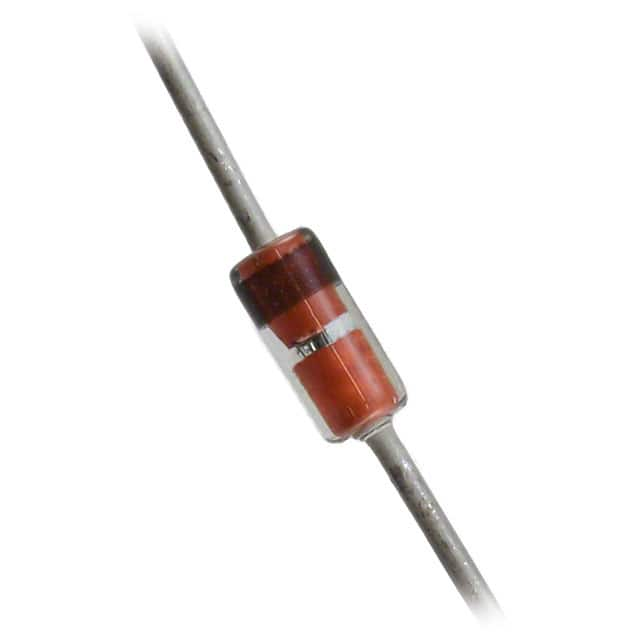BZX79C15_NT50R - Product Overview and Analysis
Introduction
The BZX79C15_NT50R is a crucial component in the field of electronics, specifically within voltage regulation and protection. This entry will provide an in-depth analysis of the product, covering its category, use, characteristics, package, essence, packaging/quantity, specifications, detailed pin configuration, functional features, advantages and disadvantages, working principles, detailed application field plans, and alternative models.
Basic Information Overview
- Category: Voltage Regulation and Protection Component
- Use: Regulating and protecting voltage in electronic circuits
- Characteristics: High precision, low leakage current, and fast response time
- Package: SOD-27, DO-35
- Essence: Zener diode
- Packaging/Quantity: Available in reels or bulk quantities
Specifications
- Voltage: 15V
- Power Dissipation: 500mW
- Zener Voltage Tolerance: ±5%
- Operating Temperature Range: -65°C to +200°C
- Storage Temperature Range: -65°C to +200°C
Detailed Pin Configuration
The BZX79C15_NT50R has a standard Zener diode pin configuration with two leads, typically denoted as anode and cathode.
Functional Features
- Voltage Regulation: Maintains a constant output voltage despite fluctuations in input voltage.
- Overvoltage Protection: Safeguards sensitive components by diverting excess voltage away from the circuit.
- Fast Response Time: Rapidly responds to changes in voltage, ensuring quick protection.
Advantages and Disadvantages
Advantages
- Precise voltage regulation
- Low leakage current
- Fast response time
- Compact size
Disadvantages
- Limited power dissipation capability
- Sensitivity to temperature variations
Working Principles
The BZX79C15_NT50R operates based on the Zener effect, where it maintains a constant voltage drop across its terminals when reverse-biased. This allows it to regulate voltage and protect the circuit from overvoltage conditions.
Detailed Application Field Plans
The BZX79C15_NT50R finds extensive use in various electronic applications, including: - Voltage regulators in power supplies - Overvoltage protection in communication systems - Signal conditioning circuits - Voltage reference sources
Detailed and Complete Alternative Models
- BZX79C12_NT50R: 12V Zener diode with similar characteristics
- BZX79C18_NT50R: 18V Zener diode for different voltage requirements
- 1N4744A: Comparable 15V Zener diode with higher power dissipation capability
In conclusion, the BZX79C15_NT50R plays a vital role in voltage regulation and protection within electronic circuits, offering precise control and fast response times. While it has certain limitations, its advantages make it a valuable component in numerous applications.
Word count: 443
قم بإدراج 10 أسئلة وإجابات شائعة تتعلق بتطبيق BZX79C15_NT50R في الحلول التقنية
What is the BZX79C15_NT50R?
- The BZX79C15_NT50R is a 15V Zener diode with a power rating of 500mW.
What are the typical applications of BZX79C15_NT50R?
- It is commonly used in voltage regulation, voltage reference, and overvoltage protection circuits.
What is the maximum power dissipation of BZX79C15_NT50R?
- The maximum power dissipation is 500mW.
What is the voltage tolerance of BZX79C15_NT50R?
- The voltage tolerance is typically +/-5%.
What is the operating temperature range for BZX79C15_NT50R?
- The operating temperature range is usually -65°C to +150°C.
How does BZX79C15_NT50R provide overvoltage protection?
- When the voltage across the diode exceeds its breakdown voltage (15V), it conducts and limits the voltage to 15V.
Can BZX79C15_NT50R be used in reverse bias?
- Yes, it can be used in reverse bias as a voltage reference or as a protection device.
What are the key characteristics that make BZX79C15_NT50R suitable for voltage regulation?
- Its stable breakdown voltage and low dynamic impedance make it suitable for voltage regulation applications.
Is BZX79C15_NT50R suitable for high-frequency applications?
- No, it is not typically recommended for high-frequency applications due to its inherent capacitance.
Are there any alternative components that can be used in place of BZX79C15_NT50R?
- Yes, other Zener diodes with similar breakdown voltages and power ratings can be used as alternatives.


